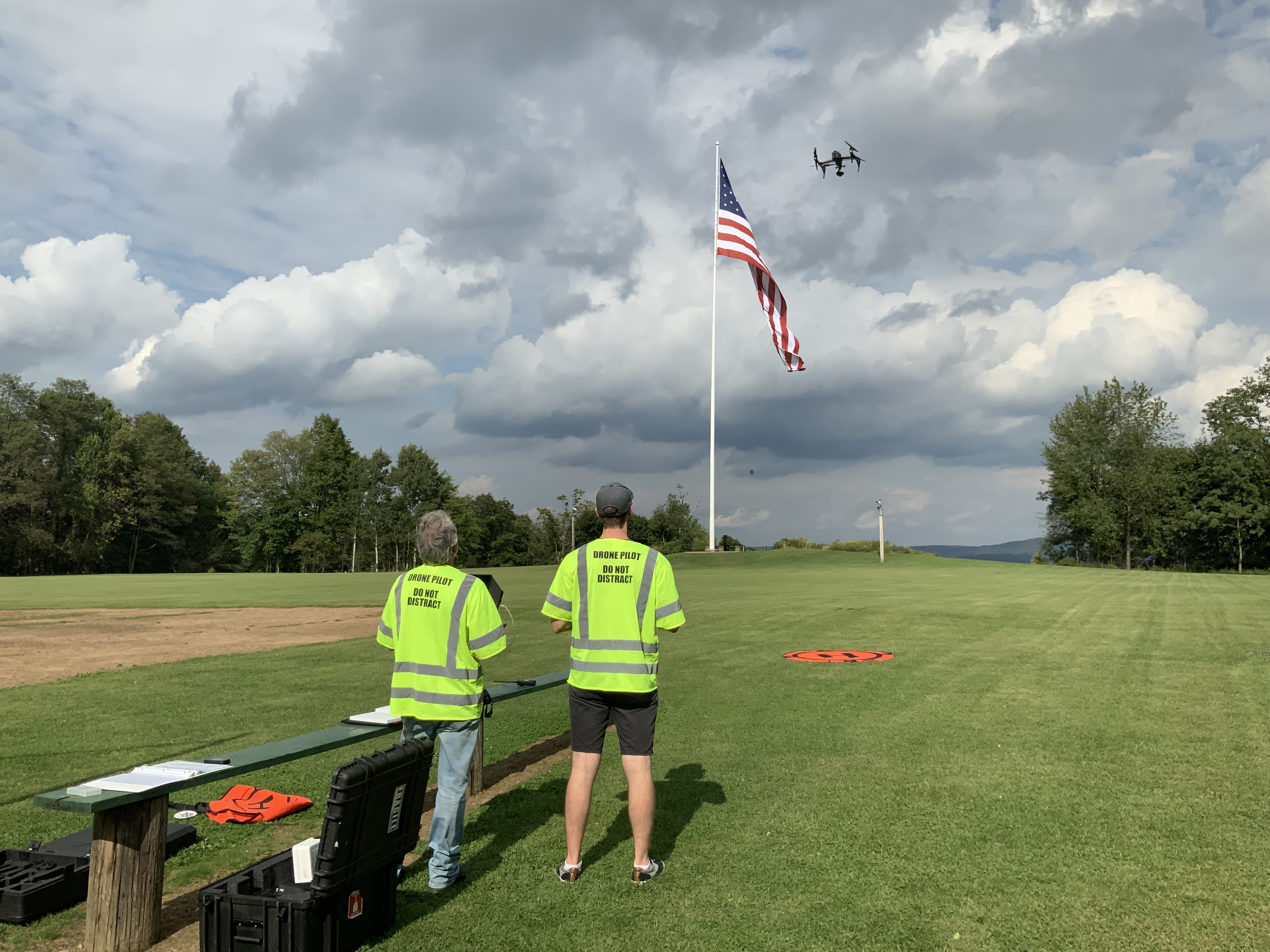Drones Now Flying Expanded Missions With FAA’s Blessing
New rules ease authorization for UAS night operations in restricted areas

OTTAWA—Recent changes to Federal Aviation Administration rules governing flight authorizations for drones (aka unmanned aerial systems/UAS or unmanned aerial vehicles/UAVs) now allow for expanded missions with less red tape. These changes, along with other recent positive advances, illustrate the advances that have taken place over the past decade as the use of UASs for TV coverage has blossomed.
More Trust from Regulators
The responsible, disciplined approach to UAS pilot training and operations pursued by U.S. broadcasters has paid off. Impressed by their willingness to embrace the spirit of the law as well as the letter, the FAA has revised their rules to give the industry more flexibility.

The new rules, “Remote ID and Operations Over People,” which the FAA published in December 2020, required UAS operators to be in compliance by September 2023 and signal a pathway to expanded flight operations, according to Jeff Rose, UAS Chief Pilot with Sinclair Broadcast Group.
“With these new rules we now also have the ability to obtain LAANC authorizations [Low Altitude Authorization Notification Authorization Capability] for flying at night in restricted airspace,” Rose said. “This automated service allows near instantaneous authorizations for night flying in restricted airspace, which is a big benefit for newsgathering.”
Scott Wilder, senior vice president of field and production operations at Fox News, describes the FAA’s improved LAANC authorization application process as “the best advance that I can speak to on the regulatory front. What used to take 60 days now takes 60 seconds. It is a true game changer. The FAA is doing a phenomenal job with it.”
That’s not all: “The FAA has been working to make it easier to fly and easier to obtain permissions to fly in locations not previously available,” Wilder added. “The FAA is also proving to be 24/7. When we have waiver requests on a Sunday evening, we hear back in an efficient manner.”

Another area where the FAA is providing more leeway to responsible UAS operators is the “Operations Over People” rule applying to pilots who fly under Part 107 of the FAA regulations, according to Dr. Shaun Passley, founder of ZenaTech, developer of the ZenaDrone 1000 totally autonomous (self-flying) UAS. “This rule allows UAV pilots to operate at night under specific conditions and provided that they complete certain training or pass knowledge tests,” he said.
The professional video industry's #1 source for news, trends and product and tech information. Sign up below.
Remote ID Makes the Difference
The FAA’s more expansive attitude towards UAS operations is built upon its requirement for these aircraft to be equipped with Standard Remote ID (SRID) transmitters.
“SRID enables the transmission of the drone serial number, brand, GPS, geometric altitude, geometric location, velocity, time of the day, emergency status, and more,” said Claudio Lisman, president, CEO and founder of ProximaVision, a consulting firm specializing in drone and nanosatellite technologies. “UAVs must have their SRIDs operational from the moment of takeoff to shut down, broadcasting message elements at 1Hz [once per second], no later than one second after the measurement of position. In fact, the vehicle will not be able to take off unless it has transmitted all of the required message elements.”

Requiring UASs to carry and use SRIDs at all times makes it possible to integrate them into air traffic control systems alongside manned aircraft. As such, “making SRIDs mandatory in manufactured drones will enable much better traffic management, security, and new applications, such as flying over areas that have been restricted up to now,” Lisman added. “It will also allow flying UAVs over people, which in the case of news and production, is almost always required.”
The SRID requirement simply expands options, according to Wilder. “The SRID rule allows us more opportunities to have a drone in the air; most recently during Hurricane Ian, hours before the heart of the storm impacted the west coast of Florida,” he said.
“Remote ID also lays the foundation of the safety and security groundwork needed for more complex drone operations,” said Dr. Passley. “The rule provides crucial information to our national security and law enforcement partners and other agencies charged with ensuring public safety.”
A New, Better View for TV News
Anyone who has been watching TV news the past two years knows how integral drone footage has become for covering stories effectively. Small wonder: Overhead drone footage can provide a framing context to a story unavailable to ground-based cameras. As well, the motion associated with drone footage makes any news story look better: it’s just more exciting to watch.
These capabilities have allowed Fox News to cover stories in entirely new ways. Take for example, the influx of undocument immigrants at the Texas/Mexico border, where Fox News has been flying drones like the DJI Matrice with thermal imaging for over a year. This kind of high-tech capability “allows us to fly at night and show what looks like high-quality surveillance images of the migrant crisis,” said Wilder. “Every day we capture the surge of migrants happening that you can’t see from the same location on the ground. Our drone coverage on the border has changed the way that story is being told.”
That being said, what really makes UASs so useful to TV news departments is their ability to deploy extremely quickly and start capturing memorable footage fast. “A drone will almost always be able to arrive on the scene faster than a car or mobile unit,” Lisman said. “That is why drones are ideal for coverage of fires, demonstrations, war zones, and sports events applications in TV news and broadcast.”
These advantages explain why UASs are proving to be as significant an enhancement to TV news production as video cameras were with their instant access to recorded footage (compared to film), and satellite trucks for getting coverage out of anywhere fast.
The result: “Local TV newscasts are using drone video daily for expanded storytelling as well as breaking news coverage,” said Rose. “Our viewers love drone video and have come to expect it regularly whether it is a compelling news story or just beautiful weather shots.” This is why Sinclair now employs 133 pilots across its station, many of whom carry a UAS with them as part of their kit. “This leads to fresh drone content daily,” he said.
BVLOS: The Next Frontier
As far as TV news UASs have come, there is still one frontier to be conquered: “Beyond Visual Line of Sight” (BVLOS) flight allows the ability to send UASs beyond the view of their operators, navigating their path by using video feeds from their cameras plus any onboard self-flying (autonomous) capabilities.

“Currently, the FAA provides waivers to professional pilots and certain organizations so they can fly BVLOS,” said Lisman; “however, those waivers are hard to obtain. The main limitation is the communication and range between the drone and pilot control. In addition, the latency needs to be very low when flying long distances. This is important, as the pilot needs real-time awareness of the topography and the terrain below.”
Historically, broadcasters such as Fox News have been “very conservative” in the kinds of UAS flight profiles they choose, an approach that has won them trust from the FAA and public alike.
“Safety is our number one priority,” Wilder explained. “I recently denied a request after thinking long and hard about it because I knew what was being requested would look amazing. But I also knew that a lower altitude safer version would be almost as amazing. We aren’t looking to impress anyone, we are looking to offer visual advantages that didn’t previously exist in the safest possible manner.”
The challenges of safe BVLOS flight are being addressed by UAS manufacturers and operators today. And when they are sufficiently resolved by SRID, onboard aircraft avoidance detection systems, and autonomous drones, expect TV news organizations to cross the BVLOS frontier in record numbers.
The use of ATSC is 100 times more precise than GPS alone, allowing for more accurate navigation."
Jeff Rose
“In the future, when drones are flying everywhere for package delivery, there will likely be drones used for news gathering flown both with a pilot in the field as we do now and also piloted remotely from beyond visual line of site,” Rose predicted. “These BVLOS drone operations could potentially be piloted remotely from the TV station or pre-deployed as a ‘drone in a box’ at strategic locations.
Rose said Sinclair will even use ATSC 3.0 technology as it becomes incorporated into drone flights, for greater precision and more accuracy. “The use of ATSC is 100 times more precise than GPS alone, allowing for more accurate navigation [from 3 meters with GPS down to 3 centimeters using ATSC datacasting],” he said.
“Every day it gets better and better,” Scott Wilder concluded. “I think within several years every photographer will be a Part 107 pilot and have their own drone. That will be a big change to expect that every story assigned has a Part 107 photographer shooting the story with the ability to have aerial imagery.”
James Careless is an award-winning journalist who has written for TV Technology since the 1990s. He has covered HDTV from the days of the six competing HDTV formats that led to the 1993 Grand Alliance, and onwards through ATSC 3.0 and OTT. He also writes for Radio World, along with other publications in aerospace, defense, public safety, streaming media, plus the amusement park industry for something different.

